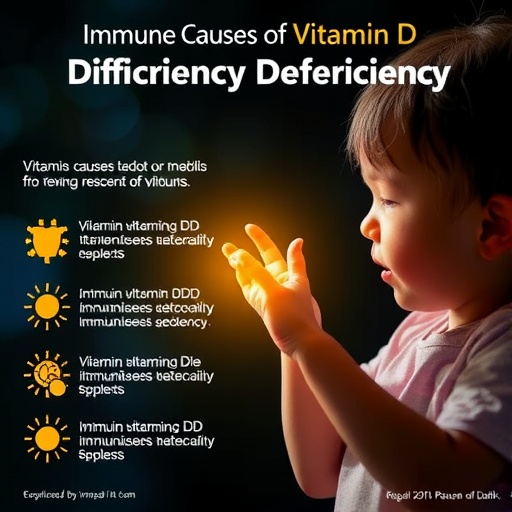
In recent years, the scientific community has witnessed a paradigm shift in understanding vitamin D deficiency, especially within pediatric populations. Traditionally, vitamin D deficiency has been largely attributed to nutritional inadequacies and insufficient sunlight exposure. However, emerging research spearheaded by Dr. C.S. Devulapalli, as published in the World Journal of Pediatrics in 2025, challenges this narrow view by elucidating the complex interplay between immune-mediated mechanisms and vitamin D metabolism in children. This groundbreaking work unveils how immune dysfunctions may provoke or exacerbate vitamin D deficiency, thus broadening the horizons for both diagnosis and treatment strategies.
Vitamin D, a secosteroid hormone, has long been recognized for its pivotal role in calcium homeostasis and bone metabolism. Yet, contemporary research has demonstrated that vitamin D’s influence extends to the immune system, where it modulates both innate and adaptive immune responses. The traditional dogma, which ascribes deficiency primarily to dietary lack and geographic variability of sunlight, is now being re-evaluated as inconsistencies appear in clinical presentations that cannot be explained by these factors alone. Dr. Devulapalli’s study delves deep into the immunological dimensions that may disrupt vitamin D synthesis, transport, or receptor function in pediatric subjects.
One of the key revelations in this research concerns the role of chronic inflammation and autoimmunity in vitamin D metabolism. Pro-inflammatory cytokines can alter the expression of enzymes responsible for converting vitamin D into its active form, 1,25-dihydroxyvitamin D. This enzymatic dysregulation can lead to diminished bioavailability of the hormone despite adequate nutritional intake and sunlight exposure. Furthermore, immune-mediated conditions such as juvenile idiopathic arthritis and type 1 diabetes frequently coincide with altered vitamin D status, suggesting a bidirectional relationship that may integrate immune pathology with endocrine disruption.
At the molecular level, vitamin D receptors (VDRs) and vitamin D-binding proteins (DBPs) are central to the hormone’s biological activity. Polymorphisms in the genes encoding these proteins can lead to impaired receptor binding or transport, compounding deficiency risks through immune mechanisms. Dr. Devulapalli’s work highlights emerging evidence that autoimmune processes can modify VDR expression on immune cells such as T-lymphocytes and macrophages. Such modifications potentially hinder intracellular signaling pathways critical for immune tolerance and vitamin D’s regulatory functions, thus perpetuating a vicious cycle of deficiency and immune dysregulation.
Moreover, this research brings attention to the concept of immune-mediated sequestration. Immune complexes and activated immune cells may sequester or degrade vitamin D metabolites, reducing systemic availability. This immune sequestration hypothesis adds a novel layer of complexity to the understanding of vitamin D homeostasis, which had previously overlooked the potential for immune cells themselves to modulate circulating levels. It also poses significant implications for interpreting serum vitamin D measurements in the context of autoimmune and inflammatory diseases.
Clinically, the implications of recognizing immune-mediated vitamin D deficiency are profound. It calls for a more nuanced diagnostic approach incorporating immunological parameters alongside traditional assays of serum 25-hydroxyvitamin D. Pediatricians and endocrinologists are urged to reconsider treatment regimens, as simple supplementation strategies might prove insufficient or ineffective in children whose vitamin D deficiency stems from immune dysfunction rather than classical causes. Immunomodulatory therapies could, therefore, become an essential adjunct to vitamin D repletion protocols.
Dr. Devulapalli’s publication also explores the intricate relationship between vitamin D status and immune system development in early childhood. Vitamin D is instrumental in shaping neonatal and infant immune responses, influencing the balance between pro-inflammatory and regulatory lymphocytes. Immune-mediated impairments in vitamin D signaling during this critical developmental window could predispose children to heightened vulnerability to infectious diseases, allergies, and autoimmune disorders, thereby highlighting the public health importance of this research focus.
Technological advances such as high-throughput gene sequencing and sophisticated immunophenotyping have enabled detailed analyses that underpin this study’s conclusions. By integrating genomics, proteomics, and immunology, this work delineates mechanistic pathways by which immunity directly affects vitamin D metabolism and vice versa. This integrative approach represents the frontier in pediatric endocrinology and immunology, providing a template for future investigations into the multifactorial etiology of nutrient deficiencies.
Additionally, environmental and epigenetic factors that modulate immune function may indirectly contribute to vitamin D deficiency in children. Exposure to pollutants, diet-induced gut microbiota dysbiosis, and psychosocial stress are factors that can provoke low-grade chronic inflammation and immune imbalance. These perturbations are capable of influencing vitamin D pathways, thereby reinforcing the idea that vitamin D deficiency cannot be fully understood without incorporating the broader immunological context.
This research also challenges the conventional public health strategies aimed at vitamin D deficiency prophylaxis. Supplementation campaigns and recommendations for increased sun exposure, while beneficial, may not suffice in immune-mediated cases. Precision medicine approaches tailored to individual immunogenetic profiles might constitute the next step in effectively combating vitamin D deficiency in pediatric cohorts with such immune intricacies.
Furthermore, the implications for vaccine responses in vitamin D-deficient children affected by immune dysregulation are an emerging area of interest. Vitamin D modulates antigen-presenting cells and T-cell responses crucial for immunogenicity. Immune-mediated impairments in vitamin D availability could potentially compromise vaccine efficacy, raising important questions about optimizing immunization strategies within this demographic.
Lastly, this research opens exciting avenues for therapeutic innovation. Targeting the immune disruptions that contribute to vitamin D deficiency holds promise for novel interventions. Strategies could include monoclonal antibodies against cytokines responsible for enzymatic impairment, small molecules that restore VDR expression, or biologics modulating vitamin D-binding protein function. Such interventions would represent a shift towards personalized medicine, improving outcomes in children grappling with complex, immune-driven vitamin D deficiencies.
In summary, Dr. C.S. Devulapalli’s 2025 study presents compelling evidence that vitamin D deficiency in children extends beyond the traditional realms of nutrition and sunlight, embedding itself deeply within immune system disturbances. This multifaceted perspective not only enhances scientific understanding but also has the potential to revolutionize clinical practice by fostering integrative diagnostics and therapeutics. As pediatric healthcare providers incorporate these insights, the hope is to mitigate the burgeoning burden of vitamin D deficiency and its associated morbidities through innovative, immune-targeted strategies.
Subject of Research: Immune-mediated mechanisms underlying vitamin D deficiency in children.
Article Title: Immune-mediated vitamin D deficiency in children: beyond nutrition and sunlight.
Article References:
Devulapalli, C.S. Immune-mediated vitamin D deficiency in children: beyond nutrition and sunlight. World J Pediatr (2025). https://doi.org/10.1007/s12519-025-00966-8
Image Credits: AI Generated
DOI: https://doi.org/10.1007/s12519-025-00966-8
Tags: calcium homeostasis and vitamin Dclinical implications of vitamin D deficiencyDr. C.S. Devulapalli research findingsemerging research on vitamin Dimmune dysfunction and vitamin D deficiencyimmune system and pediatric healthimmune-mediated vitamin D deficiency in childrennutritional inadequacies in childrenpediatric vitamin D metabolismsunlight exposure and vitamin D synthesisvitamin D treatment strategies for childrenvitamin D’s role in immune response




